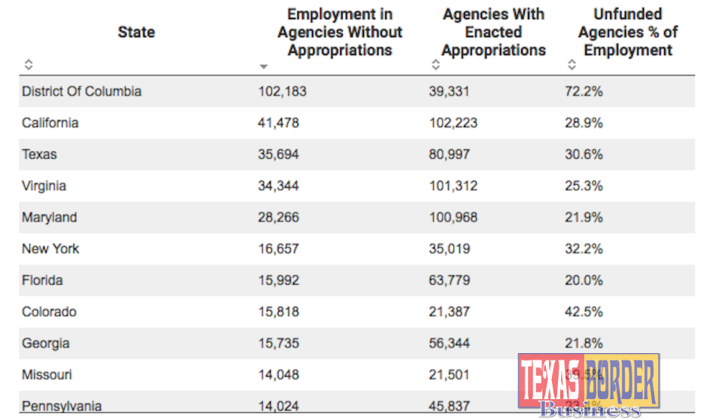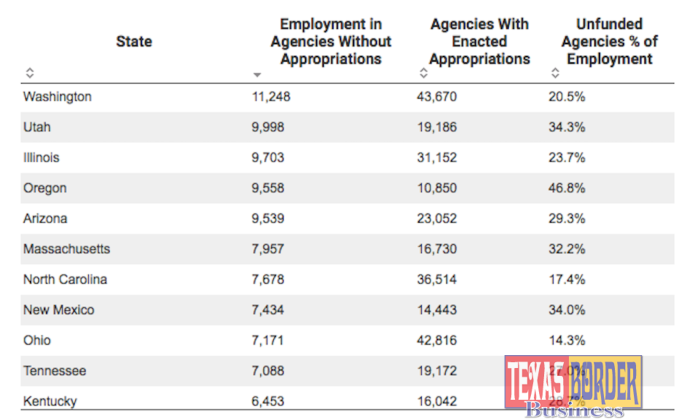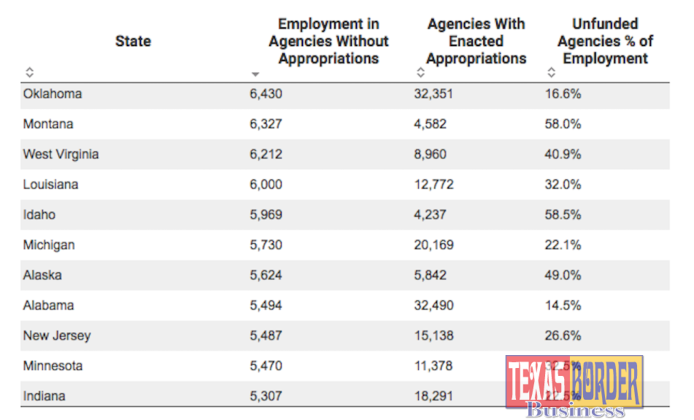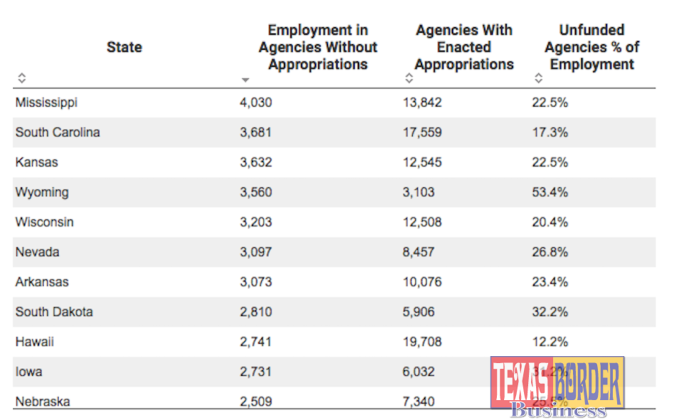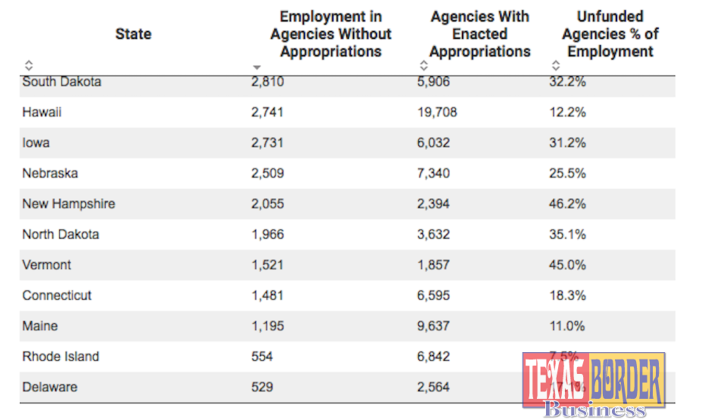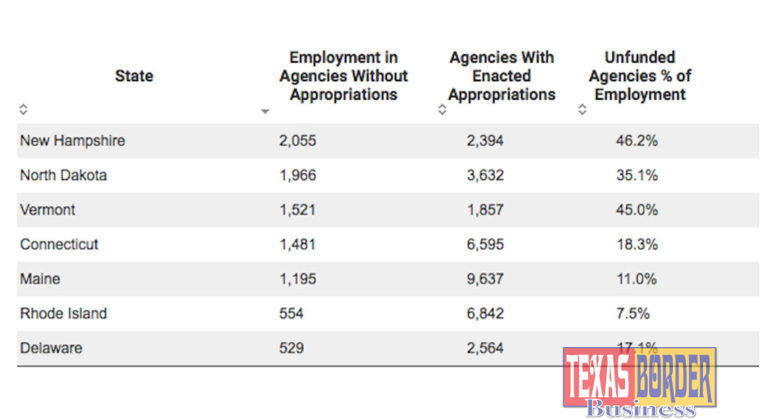About 800,000 federal employees are working without pay or will be furloughed. As the shutdown drags on, the number is expected to rise.
Texas Border Business
By Mike Maciag
As the partial federal government shutdown enters its third week, its effects on public-sector employment are far-reaching across the country.
Roughly 420,000 federal personnel are working without pay, and the Senate Appropriations Committee estimated that another 380,000 would be furloughed. While many of these jobs are concentrated around the Washington, D.C., metro area, nearly every state has a least a few thousand affected employees. And numbers are expected to gradually rise as the shutdown drags on.
For a look at impacted federal employment in each state, Governing compiled the latest data from the Office of Personnel Management (OPM). Data current as of June reflect all civilian workers, excluding those who work for the Postal Service and a limited number of smaller agencies.
Total Federal Employment by State
Among all agencies, including those untouched by the shutdown, the most employees — nearly 144,000 — worked in California, followed by the District of Columbia, Virginia and Maryland.
Federal Employees
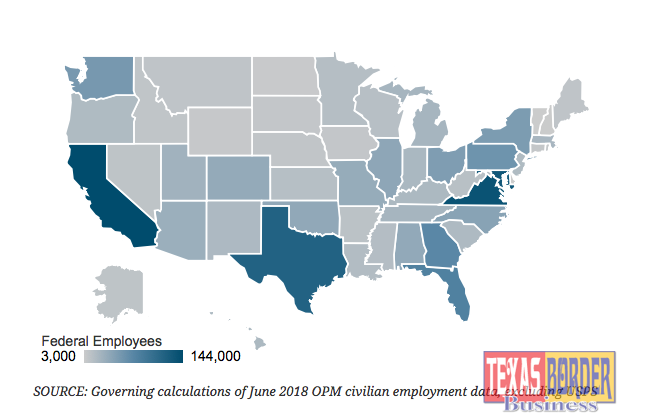
Most of these civilian employees, along with all military (which accounts for a major portion of federal employment), are still on the job. That’s because appropriations bills covering several agencies have already been signed. They include funding for the departments of Education, Energy, Defense, Health and Human Services, Labor, and Veterans Affairs, among others. Several independent agencies not reliant on federal funding are also unscathed, such as the Postal Service and Federal Deposit Insurance Corporation.
Therefore, most of the government remains open. For this reason, the current shutdown isn’t quite as pervasive as prior budget stalemates.
The largest of the remaining agencies not yet funded include the departments of Agriculture, Commerce, Homeland Security, Interior and Transportation. In these and other agencies, a sizable share of employees are furloughed or working without pay.
Employment in States Most Affected by the Shutdown
Using OPM data, we subtracted state-level employment figures for 29 agencies with enacted fiscal 2019 appropriations from remaining total civilian personnel to determine each state’s approximate number of unfunded agency employees. More than half of federal civilian personnel work for unfunded agencies in the District of Columbia, Idaho, Montana and Wyoming. In 10 other states, this share is less than one-fifth of civilian employees.
The numbers offer an approximation of the severity of the partial shutdown, but they don’t reflect actual numbers of employees furloughed or working without pay. That’s because federal law allows for some activities to continue despite a lapse in funding, such as jobs protecting people or property. Within each agency, other positions aren’t dependent on annually appropriated funds. For these reasons, it’s unknown exactly how many employees aren’t working in each state.
Here are the states with the highest number of employees working in unfunded federal agencies.
District of Columbia: 102,183 employees in agencies without appropriations
As one would expect, the consequences of the partial shutdown are felt the most in Washington, D.C. While only a small segment of federal employees work there, they’re largely employed in agencies with funding lapses. About 32,000 Homeland Security and Justice department employees are stationed in D.C., many of whom are continuing to report to work without pay. State Department, Securities and Exchange Commission and Smithsonian Institution employees are also heavily concentrated in the District, accounting for more than half the workforce for those agencies.
California: 41,478 employees in agencies without appropriations
Outside of D.C., more employees in affected agencies are based out of California than any other state. California includes many military bases, and those employees are continuing to receive paychecks. But the state is also home to nearly 10,000 employees of the Department of Agriculture, which hasn’t secured funding. The state’s federal workforce also includes approximately 7,600 Treasury Department employees and nearly 6,800 in the Department of the Interior.
Texas: 35,694 employees in agencies without appropriations
With its vast size, Texas accounts for at least a few thousand workers in nearly every major federal agency. Nearly 9,000 Treasury Department employees are stationed there, along with about 5,700 Homeland Security employees and 4,300 in the Department of Transportation. Smaller agencies with particularly high concentrations of Texas-based employees include NASA and the Small Business Administration.
Virginia: 34,344 employees in agencies without appropriations.
About a quarter of Virginia’s federal civilians work in agencies subject to the partial shutdown. Nearly 9,000 work in the Patent and Trademark Office, while another approximately 9,000 are employed with TSA, FEMA and other Department of Homeland Security agencies.
Maryland: 28,266 employees in agencies without appropriations
Many federal agencies maintain a significant presence in Maryland. The Census Bureau employs about 4,600 workers in the state, with another 3,000 in the National Oceanic and Atmospheric Administration and 2,800 in the National Institute of Standards and Technology. Another approximately 4,000 Maryland-based employees work for the Internal Revenue Service, one of the partial shutdown’s hardest-hit agencies.
Staffing for Agencies Without Enacted Appropriations
Each federal agency maintains its own contingency plan outlining how many workers are exempted from furloughs or unpaid work. Some agencies are funding positions using remaining funds from the previous fiscal year. But others, including the Department of Agriculture, have said they’ll need to furlough more workers as the shutdown persists.
Contingency plans identified the following percentages of employees in larger agencies to incur effects of funding lapses:
Data and Methodology
Data from the Office of Personnel Management, current as of June 2018, reflect numbers of civilian employees in all federal agencies, with the exceptions of the Postal Service and several small agencies. Numbers represent workers stationed in each state, not how many necessarily reside there.
Employment figures for “Agencies With Enacted Appropriations” include the following: Department of Veterans Affairs, Department of The Army, Department of The Navy, Department of The Air Force, Department of Defense, Department of Health and Human Services, Department of Energy, Department of Labor, Department of Education, Bureau of Reclamation, Nuclear Regulatory Commission, National Labor Relations Board, American Battle Monuments Commission, Institute of Museum and Library Services, Appalachian Regional Commission, Defense Nuclear Facilities Safety Board, Nuclear Waste Technical Review Board, Northern Border Regional Commission, Denali Commission, Federal Mediation and Conciliation Service, Corporation For National and Community Service, National Council On Disability, Medicaid and Chip Payment and Access Commission, Railroad Retirement Board, Federal Mine Safety and Health Review Commission, Medicare Payment Advisory Commission, Social Security Administration, Federal Deposit Insurance Corporation, Federal Deposit Insurance Corporation.
Employment figures for “Agencies Without Enacted Appropriations” represent an estimated total calculated by subtracting employment counts for the 29 above agencies with appropriated funding from total civilian employment. Data do not reflect active duty military and a few other agencies not reporting to OPM.









